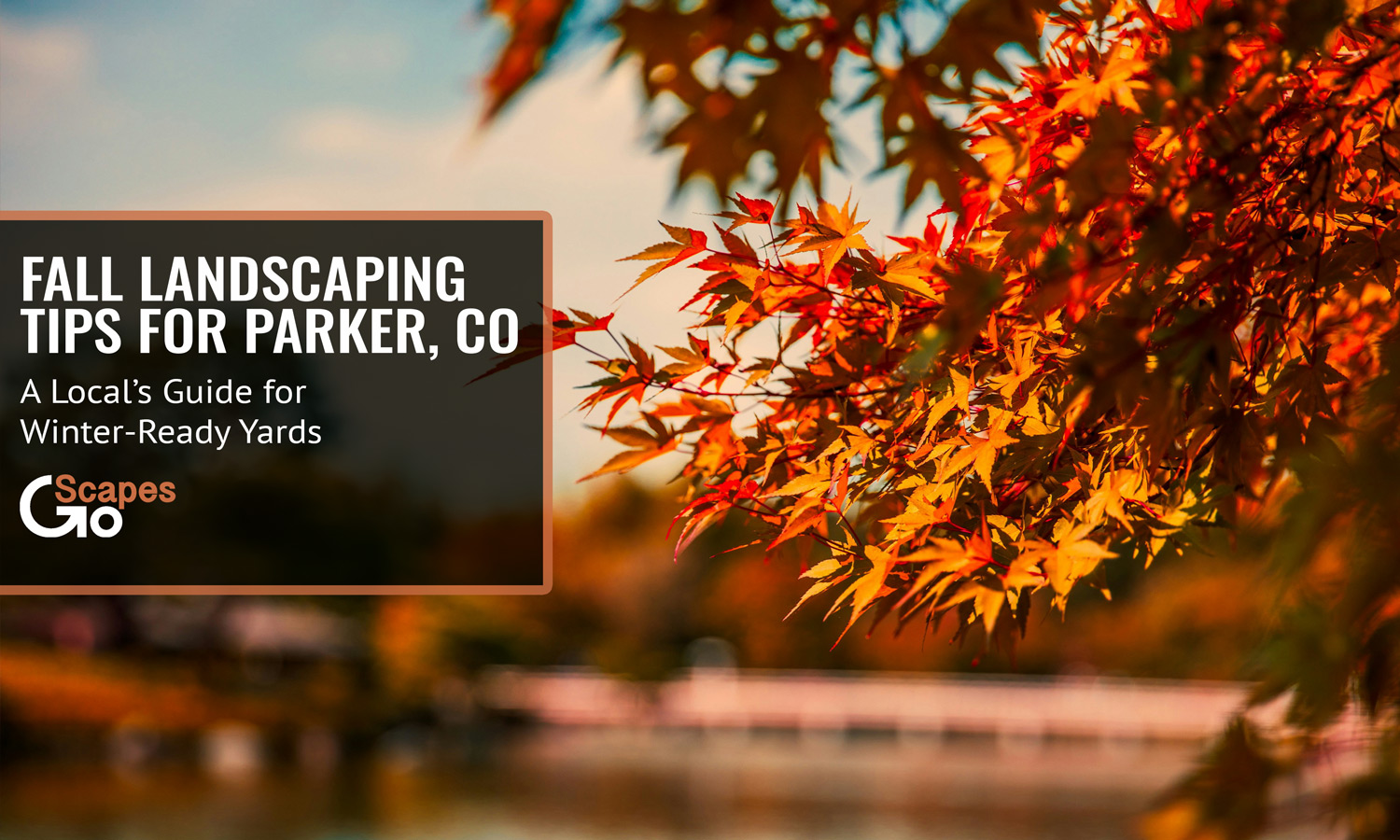Fall Landscaping Tips for a Beautiful Yard in Parker
A Local’s Guide to Winter-Ready Yards
Temps are dropping, Pumpkin Spice Lates are flowing and leaves are falling. Some homeowners have already started packing away their gardening tools. After dealing with summer heat and constant watering demands, fall feels like the perfect time to call it quits on yard work.
It may surprise you: fall is actually an ideal window for landscaping improvements. The soil stays workable, and the time between the mild fall and snowfall makes for a great time to avoid mud and puddles. Trees and shrubs planted now get a full season to establish root systems before facing their first Colorado winter.
This season also gives your existing lawn the recovery time it desperately needs. Adjusting watering schedules based on actual temperature instead of calendar dates prevents waste while keeping your grass healthy. Quality fall fertilizer helps repair summer damage and builds the reserves your lawn needs to survive winter dormancy.
Whether it’s native plants that thrive in our climate, artificial turf that stays green through winter, or efficient irrigation that actually saves water, we love helping build landscapes that work with Colorado’s conditions instead of fighting them.
Ready to make the most of fall’s landscaping advantages? Let’s build this leaf pile and jump in!
Clean and Prepare Your Outdoor Space
Social media filters aside, fall cleanup isn’t glamorous, but it’s advantageous for next year (and potentially years after). Think of it as setting the stage, you can’t put on a great show without clearing away last season’s mess first.
Remove Weeds and Dead Plants
Weeds have one job in fall: pump out as many seeds as possible before winter hits. Stop them now, or you’ll be fighting an army of baby weeds come spring. Parker’s usual suspects (bindweed, dandelion, and thistle) are particularly sneaky this time of year.
Pro tip: Pull weeds while your regular grass starts its natural fall fade. Weeds stay stubbornly green, making them easy to spot against browning grass. The soil is still warm enough that roots come out cleanly instead of snapping off and regenerating.
For tough patches where hand-pulling isn’t realistic, post-emergent herbicides work best while temperatures stay moderate. Just don’t wait until it’s too cold—effectiveness drops significantly once temperatures consistently hit the 40s.
Dead plants and debris need to go, especially anything showing disease signs like powdery mildew or black spots. Never compost diseased material, we recommend you bag it separately.
Trim Overgrown Shrubs and Trees
Snow loads can snap branches that seemed perfectly fine in October. Parker commonly gets hit with heavy, wet snows that turn neglected pruning into expensive property damage.
Focus on maintenance pruning now: dead branches, broken limbs, anything rubbing against your house or blocking walkways.
Our team sees the aftermath of “I’ll deal with it later” pruning decisions every spring. A few strategic cuts now prevent winter storm damage and keep your landscape looking intentional instead of overgrown.
Plant Smart for Fall
Selecting plants that can adapt with Colorado’s unpredictable climate will go a long way to minimize your yard-induced headache and heartache.
Choose Native and Cold-Hardy Plants
It should come as no surprise but native plants have spent thousands of years (if not more) adapting to Colorado’s wild temperature swings and unpredictable moisture patterns. Colorado blue columbine, prairie zinnia, and Rocky Mountain penstemon aren’t just pretty faces—they’re survival experts that thrive in our challenging conditions once established.
Russian sage, black-eyed Susans, and asters push through early frosts while still delivering late-season color when most other plants have given up for the year. Ornamental grasses like feather reed grass and blue fescue provide structure and movement through winter when everything else looks dormant.
Cool-Season Vegetables
If you have a garden, you may want to rotate your crops to get a final harvest before freezing nights become the norm. Leafy greens like kale, spinach, and Swiss chard actually prefer cooler temperatures and can handle light frosts that would kill warm-season crops.
Root vegetables work particularly well for fall:
- Carrots develop better flavor in cool soil
- Beets can be harvested even after snow hits
- Radishes mature quickly before hard freezes arrive
Row covers can push your harvest season even further, sometimes into December depending on the year’s weather patterns.
Use Evergreen Shrubs for Year-Round Structure
Evergreen shrubs solve one of our biggest landscaping challenges,maintaining visual interest through long, brown winters. While deciduous plants disappear for months, evergreens keep working year-round, providing color, texture, and structure when your landscape needs it most.
Dwarf mugo pine, compact juniper varieties, and Colorado blue spruce handle Parker’s winter conditions without missing a beat. These plants also create natural windbreaks and wildlife habitat, adding practical value beyond their appearance.
The goal is creating landscapes that look intentional and complete in every season, not just during spring and summer’s growing months.
Upgrade for Function and Low Maintenance
Smart upgrades this fall set you up for years of reduced maintenance and lower costs. While some improvements require upfront investment, the long-term savings in time, water bills, and ongoing maintenance make them worthwhile for most Parker homeowners.
Artificial Turf Advantages
Artificial turf eliminates the weekend chores that consume your free time. Modern synthetic grass looks remarkably natural while eliminating mowing, watering, and weeding. Your lawn stays lush and green year-round, maintaining perfect appearance even through harsh Colorado winters.
The initial cost often raises questions, but most clients find the investment pays for itself within a few years. No more fertilizer purchases, sprinkler repairs, or hiring lawn services. No more brown patches from pet damage or high-traffic areas wearing thin.
Homeowners typically cut their outdoor water usage dramatically after installing quality synthetic grass. Our turf systems are designed specifically for Colorado’s extreme temperature swings and UV exposure, ensuring your lawn looks incredible for 15-20 years with minimal maintenance.
Water-Saving Irrigation Systems
Proper irrigation installation can reduce outdoor water usage by 30-50% or more. Drip systems and microirrigation deliver water directly to plant roots, essentially eliminating runoff and waste. Smart controllers paired with rain sensors automatically adjust watering schedules based on actual weather conditions.
Traditional sprinkler systems waste water through evaporation, overspray, and poor timing. Smart irrigation eliminates these problems by delivering the right amount of water exactly where and when plants need it. These systems are customizable to create different zones tailored to specific plant needs or soil conditions.
Incorporate Xeriscaping Elements
Xeriscaping focuses on drought-tolerant landscaping techniques that minimize irrigation requirements. Often misunderstood, xeriscapes can be densely planted, lush, and colorful while keeping water usage low.
Parker’s climate makes xeriscaping particularly practical. Native plants like blue grama grass, blanketflower, and pine-leaf penstemon create beautiful displays while requiring minimal water once established. Rock gardens, decorative gravel, and strategic plant placement create striking visual elements that thrive in our dry conditions.
These elements work especially well when combined with synthetic turf and efficient irrigation—creating a landscape that looks great year-round without constant attention.
Design for Beauty and Use All Year
Fall’s early sunsets and chilly evenings shouldn’t mean the end of your outdoor enjoyment. Smart design choices turn your yard into a space that actually gets better as the weather cools down.
Outdoor Lighting
Those shortened October days hit different when your outdoor spaces suddenly feel off-limits after 6 PM. Path lights and uplighting flip that script, highlighting your best landscape features while keeping walkways safe. Well-placed lighting doesn’t just solve the visibility problem—it creates warm, inviting atmosphere that makes you want to grab a sweater and stay outside.
Fire pit areas get a dramatic boost from strategically placed accent lights that add depth and make these gathering spots feel intentionally designed. String lights over patios or pergolas bring that intimate glow that pairs perfectly with crisp air and hot drinks.
Outdoor Structure And Purpose
An outdoor kitchen gives you everything needed for serious cooking without taking over your entire backyard. Built with materials like granite countertops and custom stonework, these features handle Colorado’s weather swings while offering endless possibilities for customization.
Fire pits become the natural magnet during fall months, extending your outdoor season when indoor spaces start feeling stuffy.
Front Yard Ideas
Small touches make huge differences when it comes to fall curb appeal. Lanterns, seasonal planters, and cozy elements transform patios into spaces that feel inviting even when temperatures drop. These updates don’t just look good—they encourage you to spend more time outside with family and friends instead of hibernating indoors.
The right design choices turn your outdoor spaces into year-round assets instead of seasonal afterthoughts.
Ready to Transform Your Yard?
Request a Complimentary Consultation: If you’re ready to discuss your project, visit our website and schedule a time. We’ll discuss your vision and goals and recommend the best solution to meet your needs. No obligation, no requirement to purchase. We look forward to hearing from you!
The landscaping work you do this season creates lasting value—a beautiful, low-maintenance yard that handles Parker’s weather while giving you more time to enjoy it instead of maintaining it.



